Wolfram launches website that will recognise anything it is shown a picture of, could be the future of both humans and computers
Astoundingly accurate tool is getting even more clever as it is used more

A new website tries to recognise any picture that it is fed — and could fundamentally change the way that humans and computers understand images.
The tool is made by Stephen Wolfram, who created the Wolfram Alpha. That works in a similar way, using sophisticated programming techniques to throw out useful information — like what planes are going overhead or the movement of planets.
The tool can be found at a special website, which allows anyone to drop a picture onto the page or take one from their phone. (The site keeps the pictures that are sent in and will use them in future.)
The work is likely to tell us fundamental things about how the human brain works too, its creators claim. We might even find new kinds of classes of things in the world that we haven’t recognised before and don’t have a name for.
More immediately, the same technology could be added to different apps and services, meaning that photos and videos can be quickly sorted rather than requiring humans to look through them. Similar tools already exist in Google Plus and Flickr’s photo searching apps.
The system works similar to a human brain, and was trained like one. And like human brains, it will keep learning as it goes, and get better as more people use it.
To get it good enough at recognising, the system was fed “a few tens of millions of images”, including difficult ones like a cat in a space suit and a sloth wearing a party hat (both initially identified as “person”) and Chewbacca (which it said was a “hunting dog”).

Letting the system look at pictures of abstract art revealed even more unusual results.

As Wolfram points out, showing the system unusual pictures often throws out results that are something like a joke. It often identifies the image wrongly but in an understandable way.

“It won’t always get it right, but most of the time I think it does remarkably well,” Wolfram writes in a blog introducing the feature. “And to me what’s particularly fascinating is that when it does get something wrong, the mistakes it makes mostly seem remarkably human.”
That means, for instance, that the tool might mistake a wheel of cheese for a vanilla cheesecake — getting things wrong in a similar way to a slightly confused person.
Wolfram says that the technology is appearing now because the number of artificial neurons in the computer processing devices are becoming “within striking distance of the number of neurons in the relevant part of our brains”. While that processing power isn’t all that’s needed to make it work — the rest of the technology must do its job, too — Wolfram notes that it was unlikely we would be able to replicate the functioning of the human brain without systems that operate at a similar scale.
Join our commenting forum
Join thought-provoking conversations, follow other Independent readers and see their replies
Comments